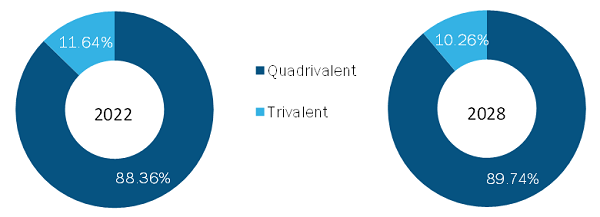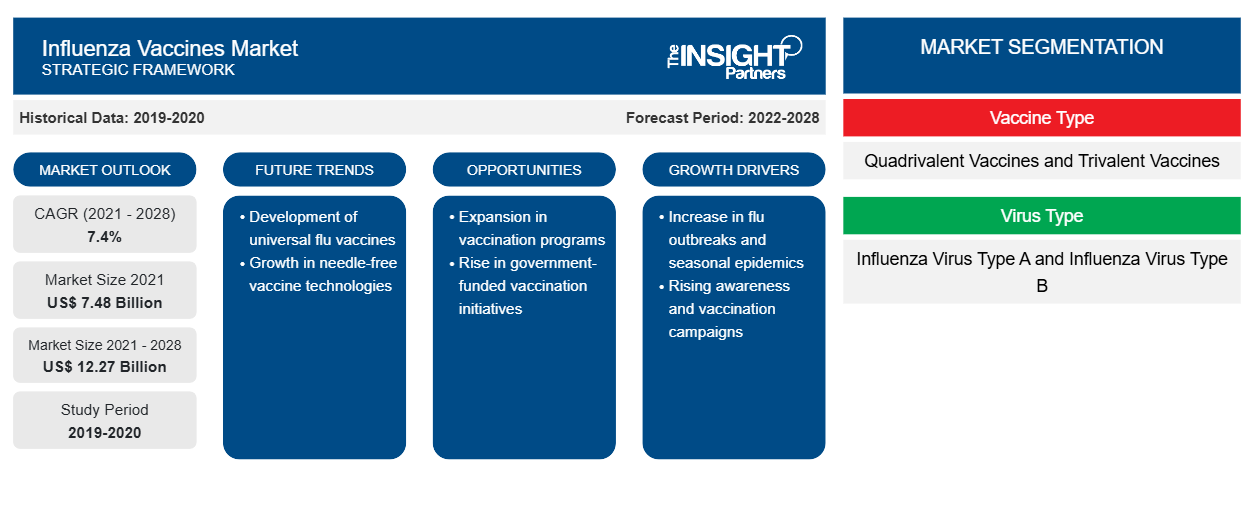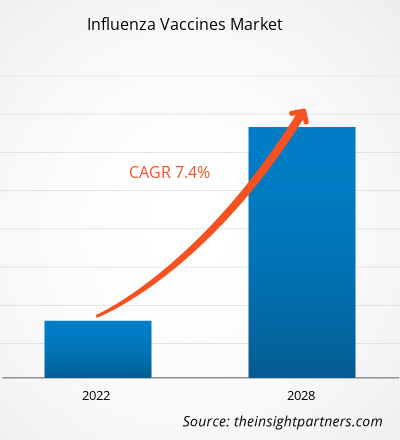2021 年流感疫苗市场价值为 74.7853 亿美元,预计到 2028 年将增长至 122.7249 亿美元;2022 年至 2028 年的复合年增长率为 7.4%
流感是由流感病毒引起的传染性呼吸道感染。流感的症状包括发烧、咳嗽、肌肉和关节疼痛、头痛和严重虚弱。流感引起的疾病从轻微到严重不等,有时会导致死亡。根据世界卫生组织 (WHO) 的数据,2018 年,与流感相关的住院病例在 300 万至 500 万例之间,而与流感相关的死亡人数约为 29 万至 65 万。建议接种疫苗以预防流感感染。流感病毒疫情在全球范围内迅速蔓延,推动了对开发有效流感疫苗的需求。强大的产品线是预测期内推动市场增长的关键因素。
流感疫苗市场分析基于疫苗类型、病毒类型、技术、给药途径、目标群体和地理位置。按地理位置划分,市场大致分为北美、欧洲、亚太地区、中东和非洲以及南美和中美洲。流感疫苗市场报告提供了对市场的深入分析和见解,强调了市场趋势、技术进步、市场动态以及主要市场参与者的竞争分析。
定制此报告以满足您的需求
您可以免费定制任何报告,包括本报告的部分内容、国家级分析、Excel 数据包,以及为初创企业和大学提供优惠和折扣
- 获取此报告的关键市场趋势。这个免费样品将包括数据分析,从市场趋势到估计和预测。
流感疫苗市场利润丰厚的地区
- 这个免费样品将包括数据分析,从市场趋势到估计和预测。
市场洞察
顶级市场参与者和政府增加投资以推动流感疫苗市场
全球市场参与者和政府正在加大对疫苗开发和免疫的投资。例如,2021 年 3 月,赛诺菲宣布在其位于多伦多和加拿大的现有工厂投资约 9.25 亿美元建造一座新的疫苗制造厂。对新工厂的投资将为赛诺菲的 FLUZONE 高剂量四价流感疫苗提供额外的抗原和灌装能力,从而在未来几年增加加拿大、美国和欧洲的供应量。
- 2021年4月,加拿大联邦政府、加拿大省政府和加拿大市政府三级政府支持赛诺菲巴斯德在多伦多建设“端到端”流感疫苗工厂。合作双方将投资近10亿美元,使工厂投入运营,预计2027年投产。总部位于巴黎的赛诺菲则将投资5500多万美元,创造165个新的合格就业岗位,并保留1100个工作岗位。联邦政府投资5500万美元,安大略省政府投资5500万美元,使该项目总投资额达到9.25亿美元。此外,赛诺菲还将在8年内每年至少投资7900万美元,用于资助加拿大的研发。
- 2020 年 11 月,疫苗制造商 Seqirus 计划投资 8 亿美元在澳大利亚建立一个重要的疫苗制造中心。Seqirus 表示,新工厂将位于墨尔本机场商业区的图拉马林,预计将于 2026 年投入使用。该公司在一份声明中没有透露所需的面积。
- 2022 年 3 月,澳大利亚政府宣布投资 1 亿美元用于季节性流感疫苗。这项投资的目的是保护人们免受流感和 COVID-19 的侵害,以最大限度地减少其对澳大利亚医疗保健的影响。
- 2021年6月,欧洲投资银行与生物技术公司Univercells签署了一项价值3055万美元的全球疫苗分销协议,将在比利时新工厂大规模生产新冠疫苗。该银行还帮助在世界各地建设其他疫苗工厂。2022年4月,该行向意大利生物医学研究公司IRBM提供了1527万美元的贷款,用于扩大其疫苗生产能力并加强对冠状病毒和其他疾病的研究。
因此,全球主要市场参与者和政府的投资增加正在促进流感疫苗市场的发展。
疫苗类型洞察
根据疫苗类型,全球流感疫苗市场分为四价疫苗和三价疫苗。四价疫苗在 2021 年占据了更大的市场份额。预计同一细分市场在预测期内将增长更快。产品批准的增加和为扩大市场而推出的产品的增加是四价疫苗细分市场增长的主要驱动力。
流感疫苗市场(按疫苗类型)——2022 年至 2028 年


- 这个免费样品将包括数据分析,从市场趋势到估计和预测。
病毒类型洞察
根据病毒类型,全球流感疫苗市场分为甲型流感病毒和乙型流感病毒。甲型流感病毒细分市场在 2021 年占据了较大的市场份额。由于甲型流感的流行率不断上升,预计预测期内甲型流感病毒的市场份额将增长更快。甲型流感病毒细分市场的市场增长归因于它是最常见的流感形式。它可以感染动物,尽管与这种流感相关的疾病更为常见。
产品审批和合作是流感疫苗市场参与者广泛采用的策略。以下列出了一些近期的关键市场发展:
- 2022 年 7 月,美国食品药品监督管理局 (FDA) 批准了赛诺菲针对即将到来的 2022-2023 年流感季节的疫苗许可申请,包括 Fluzone 高剂量四价疫苗 (流感疫苗)、Flublok 四价疫苗 (流感疫苗) 和 Fluzone 四价疫苗 (流感疫苗)。此次批准是继美国疾病控制与预防中心 (CDC) 免疫实践咨询委员会 (ACIP) 向 65 岁以上成年人优先推荐包括 Fluzone 高剂量四价疫苗和 Flublok 四价疫苗之后的又一举措。
- 2022 年 7 月,葛兰素史克宣布与加拿大政府达成协议,提供大流行和季节性流感疫苗,以帮助保护加拿大成人和儿童。这项为期四年的协议将持续到 2026 年 3 月,包括在发生流感大流行时供应多达 8000 万剂 Arepanrix(佐剂大流行性流感疫苗),以及每年至少 400 万剂 Flulaval Tetra(季节性流感疫苗)。
由于大流行期间对流感疫苗的需求增加,预计 COVID-19 大流行将推动全球流感疫苗市场的增长。根据美国疾病控制和预防中心 2021 年 11 月发布的数据,2020 年 9 月至 12 月,美国流感疫苗接种总量增加了 9.0%,青少年和成人接种的剂量比 2018 年和 2019 年 9 月至 12 月更多。
流感疫苗——市场细分
全球流感疫苗市场根据疫苗类型、病毒类型、技术、给药途径、目标群体和地理位置进行分析。根据疫苗类型,市场分为四价疫苗和三价疫苗。根据病毒类型,市场分为甲型流感病毒和乙型流感病毒。根据技术,市场分为基于鸡蛋和基于细胞。根据给药途径,市场分为注射和鼻喷剂。根据目标群体,市场可分为婴儿、儿童、成人和老年人。根据地理位置,流感疫苗市场分为北美、欧洲、亚太地区、中东和非洲以及南美洲和中美洲。
公司简介
Moderna, Inc.、SEQIRUS、Sanofi、GlaxoSmithKline plc、华兰生物工程股份有限公司、Emergent BioSolutions Inc.、三菱化学集团股份有限公司、印度血清研究所、Mylan NV 和阿斯利康是流感疫苗市场的主要公司。这些公司正在采取产品创新战略,以满足全球不断变化的客户需求,从而使他们能够在全球流感疫苗市场保持自己的品牌地位
流感疫苗报告范围
| 报告属性 | 细节 |
|---|---|
| 2021 年市场规模 | 74.8亿美元 |
| 2028 年市场规模 | 122.7亿美元 |
| 全球复合年增长率(2021 - 2028) | 7.4% |
| 史料 | 2019-2020 |
| 预测期 | 2022-2028 |
| 涵盖的领域 | 按疫苗类型
|
| 覆盖地区和国家 | 北美
|
| 市场领导者和主要公司简介 |
|
- 历史分析(2 年)、基准年、预测(7 年)及复合年增长率
- PEST 和 SWOT 分析
- 市场规模价值/数量 - 全球、区域、国家
- 行业和竞争格局
- Excel 数据集


- Artificial Turf Market
- Saudi Arabia Drywall Panels Market
- Influenza Vaccines Market
- Smart Water Metering Market
- Blood Collection Devices Market
- Animal Genetics Market
- Machine Condition Monitoring Market
- Biopharmaceutical Contract Manufacturing Market
- Medical and Research Grade Collagen Market
- Visualization and 3D Rendering Software Market

Report Coverage
Revenue forecast, Company Analysis, Industry landscape, Growth factors, and Trends

Segment Covered
This text is related
to segments covered.

Regional Scope
North America, Europe, Asia Pacific, Middle East & Africa, South & Central America

Country Scope
This text is related
to country scope.
常见问题
The quadrivalent segment held the larger share of the market in the global influenza vaccines market contributing a market share of 88.36% in 2022.
The Asia Pacific is expected to be the fastest-growing region in the influenza vaccines market over the forecast period due to growing investments from international players in China and India, increasing disposable income, and influenza cases in these regions will show promising growth in the influenza vaccines market.
The influenza vaccines market is estimated to be valued at US$ 7,478.53 million in 2021.
The influenza vaccines market is expected to be valued at US$ 12,272.49 million in 2028.
The CAGR value of the influenza vaccines market during the forecasted period of 2022-2028 is 7.4%.
The influenza vaccines market majorly consists of the players, such as Moderna, Inc.; SEQIRUS; Sanofi; GlasoSmithKline plc; Hualan Biological Engineering Inc.; Emergent Biosolutions Inc.; Mitsubishi Chemical Group Corporation; Serum Institute of India Pvt. Ltd; Mylan N. V.; and AstraZeneca
The factors that are driving the growth of the influenza vaccines market are increase in government support to promote influenza vaccination and increasing investment by top market players and governments.
Influenza virus causes flu which is a contagious respiratory illness that infects nose, throat and lungs. It can mild or severe and sometimes may lead to death. Flu vaccination every year can help in preventing flu. However, this can be deadly, especially in high-risk groups. Aged population, pregnant women and people with one or more chronic disease or with weak immune systems are at high risk. Influenza vaccines/flu shots protect against the four influenza viruses’ subtypes that are most common. Most of the influenza vaccines are “flu shots†given with a needle, usually in the arm, but nasal spray flu vaccine are also available.
Trends and growth analysis reports related to Life Sciences : READ MORE..
The List of Companies - Influenza Vaccines Market
- Moderna, Inc.
- SEQIRUS
- Sanofi
- GlaxoSmithKline plc.
- Hualan Biological Engineering Inc.
- Emergent BioSolutions Inc.
- Mitsubishi Chemical Group Corporation
- Serum Institute of India Pvt. Ltd
- MYLAN N.V.
- AstraZeneca
The Insight Partners performs research in 4 major stages: Data Collection & Secondary Research, Primary Research, Data Analysis and Data Triangulation & Final Review.
- Data Collection and Secondary Research:
As a market research and consulting firm operating from a decade, we have published and advised several client across the globe. First step for any study will start with an assessment of currently available data and insights from existing reports. Further, historical and current market information is collected from Investor Presentations, Annual Reports, SEC Filings, etc., and other information related to company’s performance and market positioning are gathered from Paid Databases (Factiva, Hoovers, and Reuters) and various other publications available in public domain.
Several associations trade associates, technical forums, institutes, societies and organization are accessed to gain technical as well as market related insights through their publications such as research papers, blogs and press releases related to the studies are referred to get cues about the market. Further, white papers, journals, magazines, and other news articles published in last 3 years are scrutinized and analyzed to understand the current market trends.
- Primary Research:
The primarily interview analysis comprise of data obtained from industry participants interview and answers to survey questions gathered by in-house primary team.
For primary research, interviews are conducted with industry experts/CEOs/Marketing Managers/VPs/Subject Matter Experts from both demand and supply side to get a 360-degree view of the market. The primary team conducts several interviews based on the complexity of the markets to understand the various market trends and dynamics which makes research more credible and precise.
A typical research interview fulfils the following functions:
- Provides first-hand information on the market size, market trends, growth trends, competitive landscape, and outlook
- Validates and strengthens in-house secondary research findings
- Develops the analysis team’s expertise and market understanding
Primary research involves email interactions and telephone interviews for each market, category, segment, and sub-segment across geographies. The participants who typically take part in such a process include, but are not limited to:
- Industry participants: VPs, business development managers, market intelligence managers and national sales managers
- Outside experts: Valuation experts, research analysts and key opinion leaders specializing in the electronics and semiconductor industry.
Below is the breakup of our primary respondents by company, designation, and region:

Once we receive the confirmation from primary research sources or primary respondents, we finalize the base year market estimation and forecast the data as per the macroeconomic and microeconomic factors assessed during data collection.
- Data Analysis:
Once data is validated through both secondary as well as primary respondents, we finalize the market estimations by hypothesis formulation and factor analysis at regional and country level.
- Macro-Economic Factor Analysis:
We analyse macroeconomic indicators such the gross domestic product (GDP), increase in the demand for goods and services across industries, technological advancement, regional economic growth, governmental policies, the influence of COVID-19, PEST analysis, and other aspects. This analysis aids in setting benchmarks for various nations/regions and approximating market splits. Additionally, the general trend of the aforementioned components aid in determining the market's development possibilities.
- Country Level Data:
Various factors that are especially aligned to the country are taken into account to determine the market size for a certain area and country, including the presence of vendors, such as headquarters and offices, the country's GDP, demand patterns, and industry growth. To comprehend the market dynamics for the nation, a number of growth variables, inhibitors, application areas, and current market trends are researched. The aforementioned elements aid in determining the country's overall market's growth potential.
- Company Profile:
The “Table of Contents” is formulated by listing and analyzing more than 25 - 30 companies operating in the market ecosystem across geographies. However, we profile only 10 companies as a standard practice in our syndicate reports. These 10 companies comprise leading, emerging, and regional players. Nonetheless, our analysis is not restricted to the 10 listed companies, we also analyze other companies present in the market to develop a holistic view and understand the prevailing trends. The “Company Profiles” section in the report covers key facts, business description, products & services, financial information, SWOT analysis, and key developments. The financial information presented is extracted from the annual reports and official documents of the publicly listed companies. Upon collecting the information for the sections of respective companies, we verify them via various primary sources and then compile the data in respective company profiles. The company level information helps us in deriving the base number as well as in forecasting the market size.
- Developing Base Number:
Aggregation of sales statistics (2020-2022) and macro-economic factor, and other secondary and primary research insights are utilized to arrive at base number and related market shares for 2022. The data gaps are identified in this step and relevant market data is analyzed, collected from paid primary interviews or databases. On finalizing the base year market size, forecasts are developed on the basis of macro-economic, industry and market growth factors and company level analysis.
- Data Triangulation and Final Review:
The market findings and base year market size calculations are validated from supply as well as demand side. Demand side validations are based on macro-economic factor analysis and benchmarks for respective regions and countries. In case of supply side validations, revenues of major companies are estimated (in case not available) based on industry benchmark, approximate number of employees, product portfolio, and primary interviews revenues are gathered. Further revenue from target product/service segment is assessed to avoid overshooting of market statistics. In case of heavy deviations between supply and demand side values, all thes steps are repeated to achieve synchronization.
We follow an iterative model, wherein we share our research findings with Subject Matter Experts (SME’s) and Key Opinion Leaders (KOLs) until consensus view of the market is not formulated – this model negates any drastic deviation in the opinions of experts. Only validated and universally acceptable research findings are quoted in our reports.
We have important check points that we use to validate our research findings – which we call – data triangulation, where we validate the information, we generate from secondary sources with primary interviews and then we re-validate with our internal data bases and Subject matter experts. This comprehensive model enables us to deliver high quality, reliable data in shortest possible time.


 获取此报告的免费样本
获取此报告的免费样本